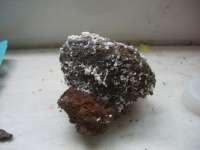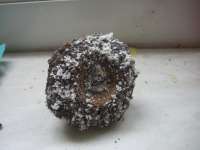 IAS on Facebook IAS on Facebook
 IAS on Instagram IAS on Instagram

|

IAS Aroid Quasi Forum
About Aroid-L
This is a continuously updated archive of the Aroid-L mailing list in a forum format - not an actual Forum. If you want to post, you will still need to register for the Aroid-L mailing list and send your postings by e-mail for moderation in the normal way.
|
Strange white mold/spots on amorphophallus tubers
|
From: David <onimua at gmail.com> on 2009.09.30 at 17:29:20(20104)


Hello fellow aroiders!
Recently, I noticed an odd problem with my amorphophallus tubers - they started growing mold. At first, I thought it was just small specs of perlite and I brushed it off, and put it into storage for their dormant period. I check them once a week, just in case of anything, and I noticed it was back, but much more. I brushed it off, and it was this odd fluff (best way to describe it) and it spread to the other tubers as well. I checked, and the tubers are not soft and seem just fine except this odd fluff-like white mold that is growing on the surface of them. I'm not sure what it is, or how to get rid of it. Any ideas?
I also attached some pictures I took of said "fluff" mold.
Thanks!
--0016364c7513067d900474cedfb7----0016364c7513067d980474cedfb9 | HTML |
|
From: "Wilbert Hetterscheid" <hetter at xs4all.nl> on 2009.09.30 at 20:36:53(20108)
This looks suspiciously like root mealy bugs.
Wilbert
| +More |
> -----Oorspronkelijk bericht-----
> Van: aroid-l-bounces@gizmoworks.com
> [mailto:aroid-l-bounces@gizmoworks.com] Namens David
> Verzonden: woensdag 30 september 2009 19:29
> Aan: aroid-l@gizmoworks.com
> Onderwerp: [Aroid-l] Strange white mold/spots on amorphophallus tubers
>
> Hello fellow aroiders!
>
> Recently, I noticed an odd problem with my amorphophallus
> tubers - they started growing mold. At first, I thought it
> was just small specs of perlite and I brushed it off, and put
> it into storage for their dormant period. I check them once a
> week, just in case of anything, and I noticed it was back,
> but much more. I brushed it off, and it was this odd fluff
> (best way to describe it) and it spread to the other tubers
> as well. I checked, and the tubers are not soft and seem just
> fine except this odd fluff-like white mold that is growing on
> the surface of them. I'm not sure what it is, or how to get
> rid of it. Any ideas?
>
> I also attached some pictures I took of said "fluff" mold.
>
> Thanks!
>
>
_______________________________________________
Aroid-L mailing list
Aroid-L@www.gizmoworks.com
http://www.gizmoworks.com/mailman/listinfo/aroid-l
|
|
From: michael kolaczewski <mjkolaffhbc at sbcglobal.net> on 2009.10.01 at 04:02:02(20115)
Greetings David,
I will cast my vote with Mr. Wilbert.
Mealy bugs can be found on leaves, branches, roots, and tubers.
I had just this weekend began to bring in several Amorpophallus,
along with other Aroids and other tropicals.
Several of my plants have Mealybugs, ( on the roots and tubers) as well.
You can have several over lapping generations once they establish themselves.
females can lay hundreds of eggs, after a month or so you are up to your ears
in Mealybugs.
Treatment can be simple and low toxic. You can use insecticidal
soap, or any botanical insecticide. You could also use a horticultural
oil. All these products are applied as a spray. An "old" remedy used around here
by old timers, is to use a little bit more than a teaspoon each of dish soap and ammonia,
in a quart sprayer. which ever method you employ, be sure to thoroughly cover them.
I do try to clean off as many as possible, to lower the population, and effect better
coverage with the above mentioned products.
You can dab them with rubbing alcohol, on a Q-tip, or cotton ball.
They are a bit more harder to control when the plants are in pots, with the roots
contained within the growing media or soil mix. In some cases, drenching the media with
a bit more stronger product, might be needed, since you will have insects of varying stages,
within the media and the root system.
Hope this will be of use to you.
Michael Kolaczewski
| HTML +More |
From: David
To: aroid-l@gizmoworks.com
Sent: Wednesday, September 30, 2009 12:29:20 PM
Subject: [Aroid-l] Strange white mold/spots on amorphophallus tubers
Hello fellow aroiders!
Recently, I noticed an odd problem with my amorphophallus tubers - they started growing mold. At first, I thought it was just small specs of perlite and I brushed it off, and put it into storage for their dormant period. I check them once a week, just in case of anything, and I noticed it was back, but much more. I brushed it off, and it was this odd fluff (best way to describe it) and it spread to the other tubers as well. I checked, and the tubers are not soft and seem just fine except this odd fluff-like white mold that is growing on the surface of them. I'm not sure what it is, or how to get rid of it. Any ideas?
I also attached some pictures I took of said "fluff" mold.
Thanks!
--0-550850244-1254369722=:16798----==============A22286562281089341=� |
|
From: "D. Scott Taylor" <scott.taylor at brevardparks.com> on 2009.10.01 at 19:23:34(20125)
Mealy bugs: if you store them in dark, damp locales they can be a problem: if a real concern, a little malathion drench will take care of it.
On Sep 30, 2009, at 1:29 PM, David wrote:
| HTML +More | |
Hello fellow aroiders!
Recently, I noticed an odd problem with my amorphophallus tubers - they started growing mold. At first, I thought it was just small specs of perlite and I brushed it off, and put it into storage for their dormant period. I check them once a week, just in case of anything, and I noticed it was back, but much more. I brushed it off, and it was this odd fluff (best way to describe it) and it spread to the other tubers as well. I checked, and the tubers are not soft and seem just fine except this odd fluff-like white mold that is growing on the surface of them. I'm not sure what it is, or how to get rid of it. Any ideas?
I also attached some pictures I took of said "fluff" mold.
Thanks!
_______________________________________________
Aroid-L mailing list
Aroid-L@www.gizmoworks.com
http://www.gizmoworks.com/mailman/listinfo/aroid-l
D. Scott Taylor, Ph.D.
Brevard County Environmentally Endangered Lands Program
91 East Dr.
Melbourne, Florida 32904
tel: 321.255.4466
FAX: 321.255.4499
email: scott.taylor@brevardparks.com
--Apple-Mail-9--907576406----==============C51265693229147255=� |
|
From: David <onimua at gmail.com> on 2009.10.01 at 19:39:41(20127)
Hey guys,
I want to thank everyone for the advice so far. I had no idea they were root mealybugs (I thought they looked different). I'm currently soaking the tubers in mix of insecticidal soap and water for a few minutes. My other fear is the Amorphophallus I have in pots. I don't think digging them up, soaking, and then repotting is a good idea, but not sure how to prevent, and perhaps stop if they're already there, the mealybugs from attacking the other plants. Can I pour a weaker soap/water mix into the pot the same way I water them? Would that work?
And if I have root mealybugs, will I have to worry about the other kind that attacks the leaves? I also have orchids and some staghorn ferns (small ones) in that same room - are they in any danger?
Thanks again!
| HTML +More | |
--0016e64c1bc409d8300474e4cf57----==============�20789216940308163=� |
| |
Note: this is a very old post, so no reply function is available.
|
|




